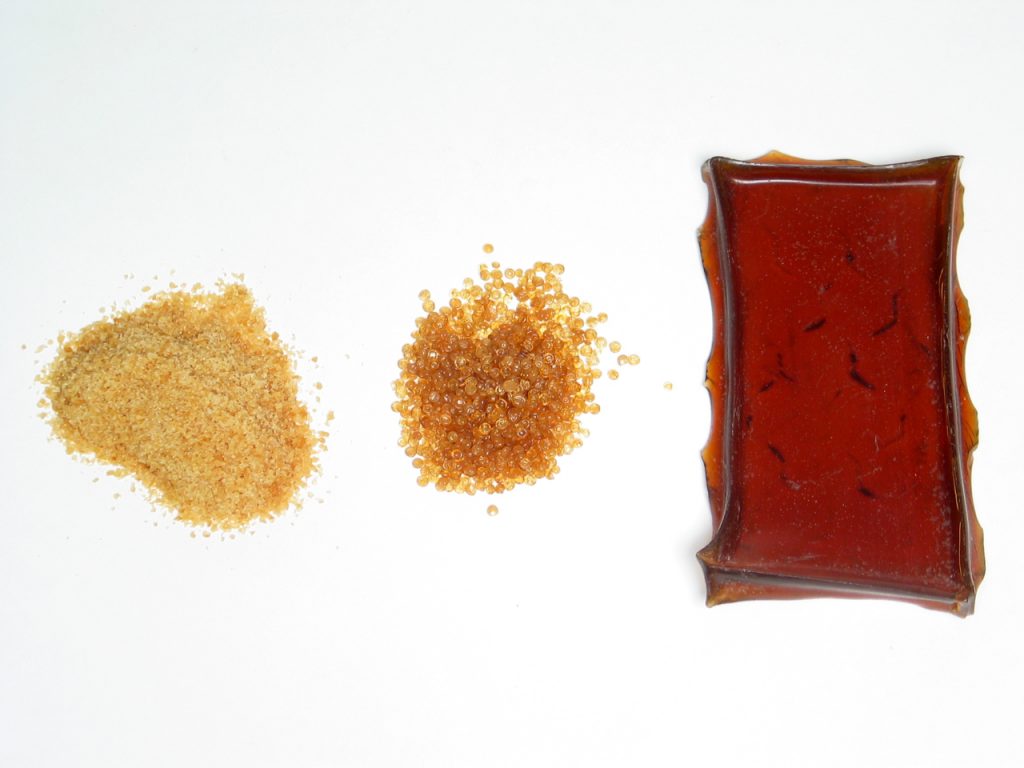We may receive a commission when you use our affiliate links. However, this does not impact our recommendations.

Most hide glue is available as small granules (left) that soak up water and become ready to heat quickly. Some hide glue is available as “pearls,” which take longer to become ready. In the old days hide glue was sold as “bricks,” which you had to break up and soak for a long time before heating. All three forms have an infinite shelf life when kept dry.
You can’t really talk about repairing antique furniture without explaining hide glue because it was the glue used on almost all furniture made before the 1950s. So, with this post I’m introducing what I hope will be a series of posts in the coming months on hide glue.
I’ve written about hide glue many times, including in Popular Woodworking (Aug., 2007; reprinted in “Flexner on Finishing”), and I show its use extensively in my DVD, “Repairing Furniture.”
I want to emphasize that unless I specify differently I’m always referring to hot hide glue when I use the term “hide glue.” Though I intend to say something about liquid hide glue, it doesn’t have the characteristics of hot hide glue that I find so useful for repairing old furniture glued originally with hide glue. It doesn’t have the heat, and it doesn’t have the quick tack. Liquid hide glue works more like white or yellow glue, just with a longer open time. For repair work, liquid hide glue has the same limitations these glues do.
On the other hand, hot hide glue is more difficult to use and needs to be prepared ahead of time. It’s not just sitting on the shelf ready for instant use. It’s also more expensive, largely because of waste – if expense is even an issue when this glue makes the work go easier and faster.
I first started using hot hide glue in my restoration shop in 1978. In 1980 I attended a workshop in Vermont dedicated to using hide glue; it was taught by a British furniture restorer. But by then I had pretty well figured it out on my own, so I just had confirmed that hide glue was the right way to go on valuable antiques.
Hot hide glue was the glue used by almost all woodworkers and furniture factories until the 1950s when white glue – polyvinyl acetate (PVA) – became available. Elmer’s was one of the first of these glues.
So you can assume that almost all furniture and other wood objects made before the 1950s were glued originally with hide glue, and all repair work done before the 1950s was done with hide glue. (I believe that a major reason for the survival of so much old and antique furniture is due to hot hide glue being the only glue available for so long; I’ve seen so much destruction caused by the use of modern synthetic glues.)
Hide glue is made from animal skins. Today, the skins used are almost always from cows, explaining why glue factories have been located near tanneries. The scraps would be turned into glue. But at some point horsehides may have been used, giving rise to the expression “take the horse to the glue factory.” Other animal skins are also used for specialized glues, but not for woodworking.
You’re going to be hit with a lot about hide glue in the coming months, because I know that Chris Schwarz is working on an article for Popular Woodworking Magazine on using liquid hide glue. I’m looking forward to what he has to say.
— Bob Flexner
Here are some supplies and tools we find essential in our everyday work around the shop. We may receive a commission from sales referred by our links; however, we have carefully selected these products for their usefulness and quality.










I’ve never used anything but Titebond or Elmer’s over the years. and occasional JB Weld for certain assemblies. This will be interesting, so thanks, Bob. I have only one of your books on finishing but it is THICK with information, and I can’t recommend it enough.
As with shellac, you can buy this in solid form. You can’t go down to HD or the blue store though. Heck I don’t know if WoodC carries the stuff. I can only find it on Amazon. So info on sourcing would be great as well (which you probably already have covered).